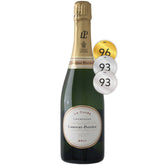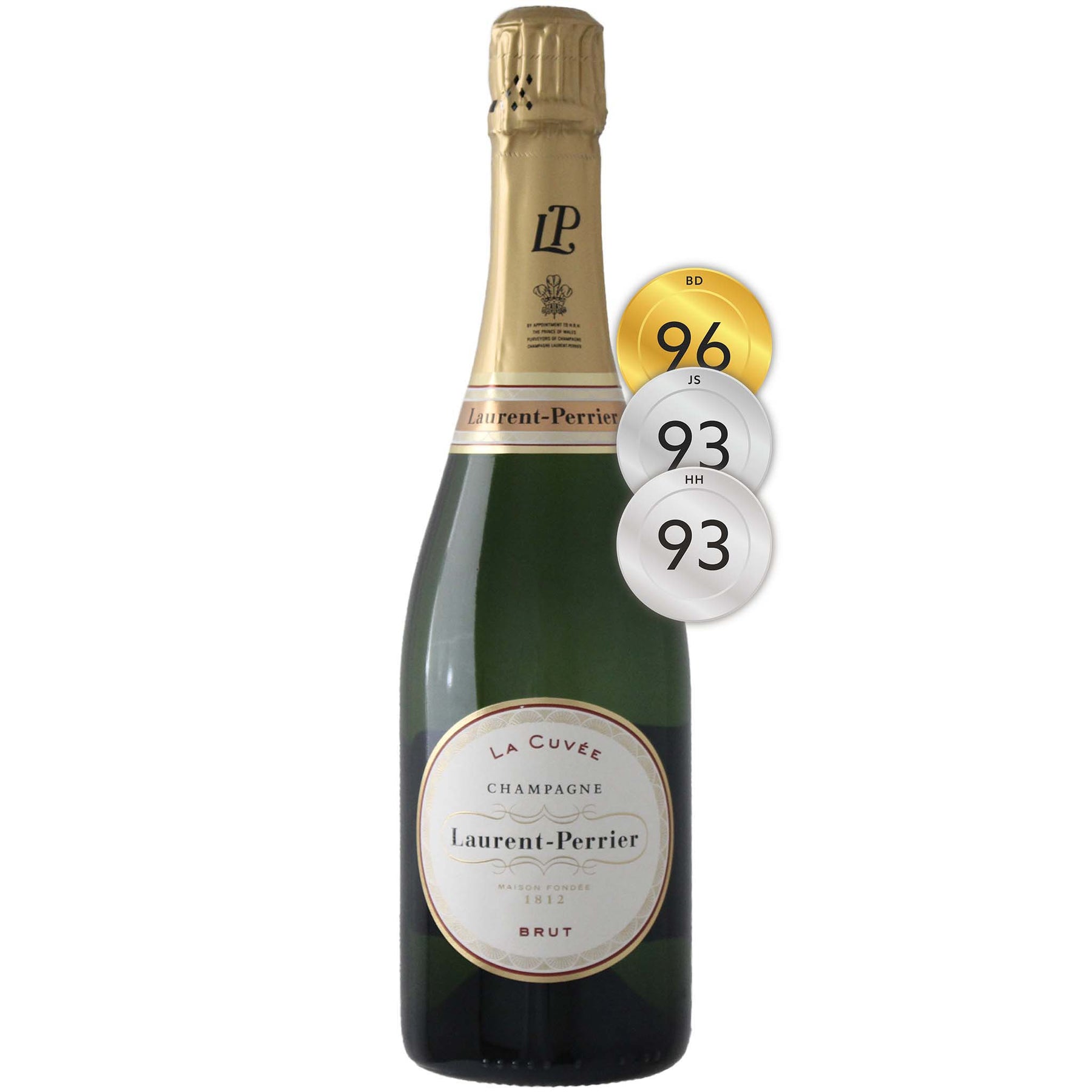
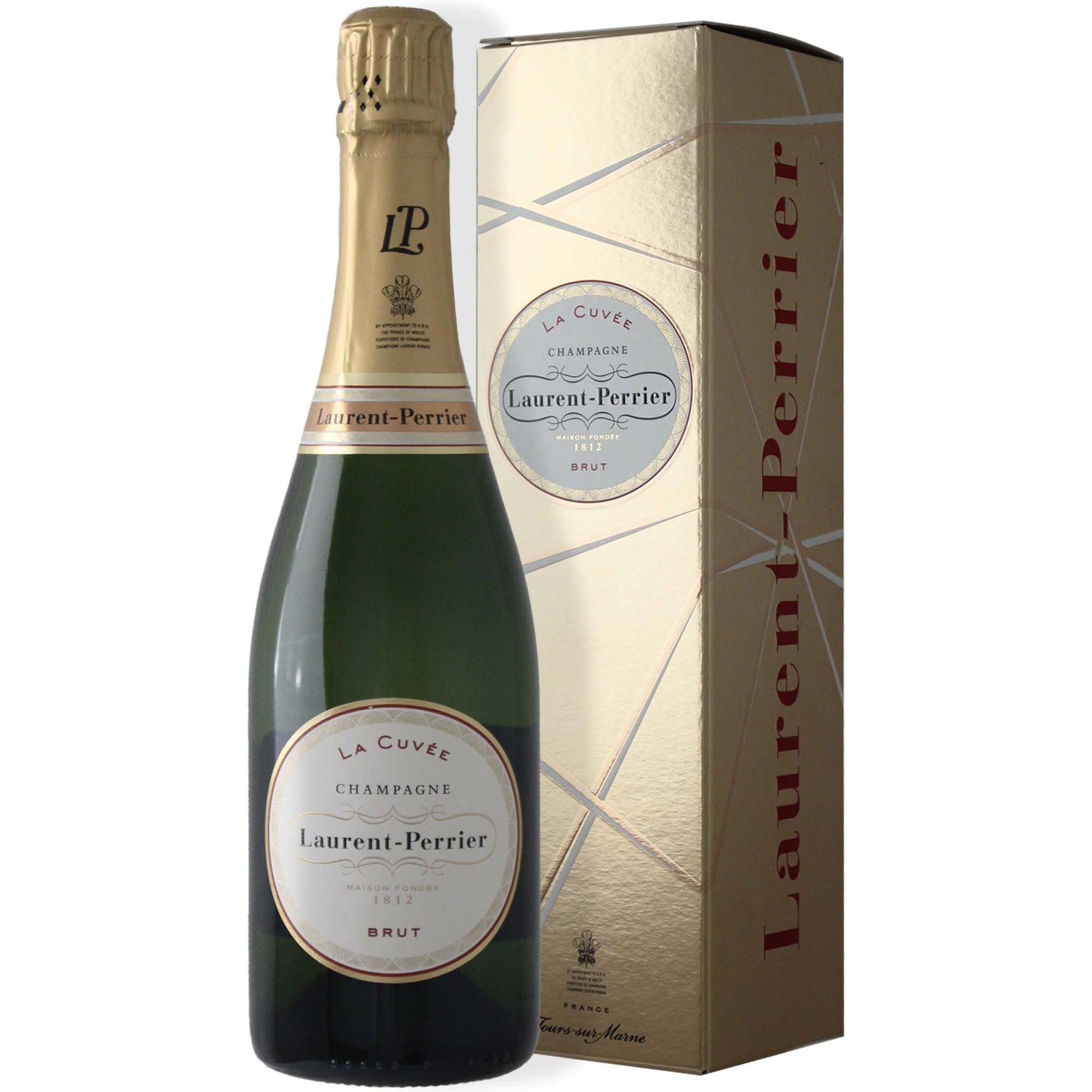
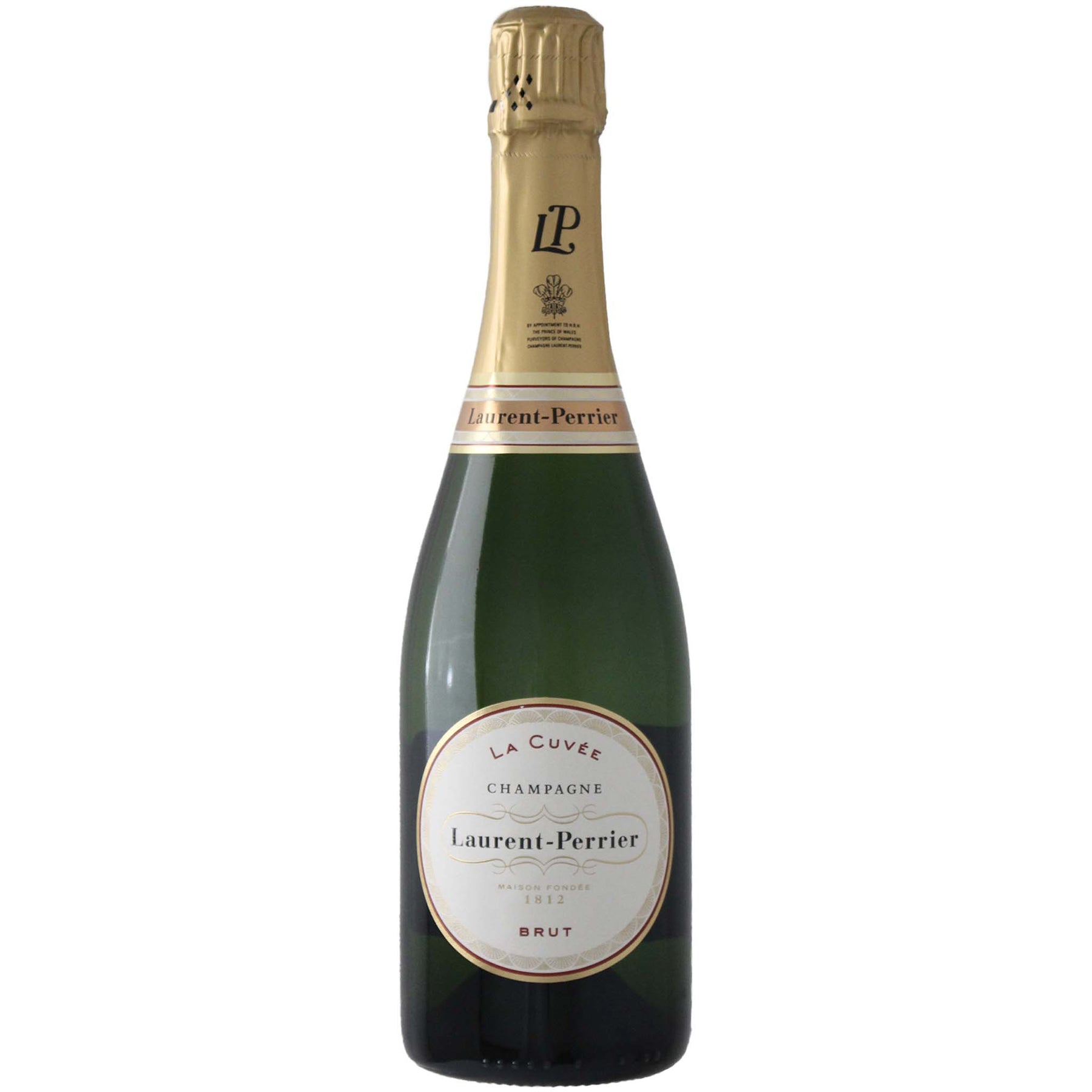
Laurent-Perrier Brut La Cuvée NV (Gift Box)
Style: Champagne Brut
Varieties: Chardonnay (50%), Pinot Noir (35%), Pinot Meunier (15%)
Closure: Cork
Laurent-Perrier Brut La Cuvée NV (Gift Box)
Warehouse
34 Redland Drive
Vermont VIC 3133
Australia
Producer: Laurent-Perrier
Country: France
Region: Champagne
Vintage: Non Vintage
Critic Score: 96
Alcohol: 12.0% Dosage: 9g/l
Size: 750 ml
Drink by: 2030
Founded in 1812, Laurent-Perrier is one of the finest and largest Champagne Houses, producing around 7 million bottles annually. The current release of Laurent-Perrier Brut La Cuvée is based on the 2016 vintage and was disgorged in December 2022. It is a blend of 50% Chardonnay, 35% Pinot Noir and 15% Pinot Meunier sourced from over 100 crus in the Côtes des Blancs, Montagne de Reims and Vallée de la Marne. The high proportion of Chardonnay defines the style and personality of the wine - purity, freshness and elegance. Up to 30% of reserve wines go into the blend which spends 4 years on lees.
"Light yellow hue, fresh aromas of straw and small flowers, iced patisseries, the palate delicate and intense, cleansing dryness on the finish and really smart vitality, balance and length. White fruit shows. It really dances on the tongue." Huon Hooke
"A pale gold colour. Fine bubbles feed a persistent mousse. A delicate nose with hints of fresh citrus and white flowers. The wine’s complexity is expressed in successive notes such as those of vine peach and white fruit. A perfect balance between freshness and delicacy with fruity flavours very present on the finish." Laurent-Perrier
Expert reviews
Chef de cave
 Michel Fauconnet, Chef de Cave Laurent-Perrier from 2004-2023
Michel Fauconnet, Chef de Cave Laurent-Perrier from 2004-2023
The following text is taken from an article that appeared in Bon Couer Fine Wines
Michel Fauconnet first joined Laurent-Perrier in August 1973 doing work experience in the cellars after getting a certificate in agricultural engineering at the Agricultural College of Rethel, in the Ardennes region. He has acquired his experience on the ground.
Fauconnet climbed the ladder at Laurent-Perrier, working as a manual worker from 1974 to 1976 before being promoted to technical staff in 1980. Four years later, in February 2004, he was appointed Chef de Cave and became responsible for Laurent-Perrier’s winery and the fermentation process of all of Laurent-Perrier’s wines.
Michel Fauconnet took over from Alain Terrier, who retired after 30 years and to whom he was Executive Deputy. For more than 20 years and alongside Alain Terrier - a man who was good at training and loved to pass on his knowledge - they created pleasurable wines based on solid know-how and building strong relationships with grape-growers. At his side, Mr Fauconnet also assimilated his oenology knowledge and worked hand-in-hand with a closeknit team he has now made his own.
Michel Fauconnet has spent his entire working life at Laurent-Perrier and is dedicated to the company with whom he shares a passion for champagne and family values built on perfection and great expectation. Fond of sport and a football lover, he played at top level at the Stade de Reims. He is a thorough man with a strong personality who has won the respect of grape growers and the Champagne community.
You have been at the House of Laurent-Perrier for over 40 years, how did you begin your career?
I joined Laurent-Perrier on August 28, 1973. I had sent a letter to the late Bernard de Nonancourt, asking for work-experience. I never left the House.
Describe the spirit of Laurent-Perrier and how it stands out from other Grand Marques?
Originally founded in 1812, the House of Laurent-Perrier is now recognised as one of the largest independent and family-owned champagne brands. It is the style and quality of our wines which enable Laurent-Perrier to stand out. We have supply of excellent Chardonnay grapes, backbone of Laurent-Perrier’s style.
Describe Laurent-Perrier vineyards and your unique relationships with the growers/suppliers you work with.
Laurent-Perrier owns 10% of its needs. Our vineyards are mainly located in the areas of the Côte des Blancs for Chardonnay, and the Montagne de Reims for Pinot Noir. We nurture our lasting relationships with wine growers. Some of our partners are from the third generation! It means the quality of our supply is consistent. We share the same respect for nature and traditional values.
We recently visited Laurent-Perrier and had the pleasure of going into the cellars. It was very impressive. Can you describe the cellars and the work that’s carried out there?
There are more than 9km (6 miles) of cellars, built in chalk (Champagne’s typical terroir stone) at the historical estate of Laurent-Perrier in Tours-sur-Marne. We have built an extension in 2008-2009 with new state-of-theart stainless steel tanks. And to mark our 200th anniversary, we unveiled a new winery, dedicated to our prestige cuvee Grand Siècle, last year. We have invested much effort into our vinification equipment and installations which are state of the art technology, whilst retaining our tradition and values.
Can you describe the Laurent-Perrier blending process, who is involved and when, where does it take place?
Champagne is made by assemblage: the blending of different varietals under appellation (Chardonnay, Pinot Noir and Pinot Meunier, depending on the cuvées), coming from different crus (villages of growth). We systematically separate varietals and crus at time of harvest (no Chardonnay from Avize with Chardonnay from Oger, etc). It means that I have several hundreds of different 'clear wines' to taste. For each of our cuvées and according to each style, I must identify the wines before the final blend. It means projecting yourself four years ahead when the wine will be ready after ageing. It is the savoir-faire of the House. I am the final decision-maker but am working with a small team.
Grand Siècle is a blend of many different vintages and a very special cuvée – could you tell us more about this wine and the stages of its development?
In 1959, Bernard de Nonancourt launched Grand Siècle, his prestige cuvée, the quintessence of the art of blending. He concentrated on two essential components of traditional champagne savoir-faire. The careful blending of the greatest crus and of wines from three particularly outstanding harvests declared as vintage years by Laurent-Perrier. In a word: 'The best of the best with the best'!
You were made Cellar Master in 2004 – over the lifetime of your career what have been your greatest moments in the job to date and who has influenced you most in your career?
Working alongside Bernard de Nonancourt, and having his trust has been the highlight of my career. But I spent 30 years as deputy to the previous cellar master, Alain Terrier, who taught me everything. The period between 1975-1985 was a happy time. There were a lot of changes in practises and evolution in our job, particularly in the technique of maceration of Pinot Noir and extracting all its aromas for our Cuvée Rosé Laurent-Perrier. It was all very exciting.
What are your top three Champagne vintages of the last 50 years and why?
1995: Perfect balance between Chardonnay and Pinot Noir, typical of Laurent-Perrier style for our blends. 1990: Atypical year, superb for its Chardonnay. 1976: Another atypical year with both quality and maturity, despite a small yield.
 Maximilien Bernardeau, Chef de Cave Laurent-Perrier from 2023
Maximilien Bernardeau, Chef de Cave Laurent-Perrier from 2023
Maximilien Bernardeau was appointed Cellar Master (Chef de Cave) and Head of Wines for the Laurent-Perrier Group in July 2023. Bernardeau will continue to report to the retiring Chef de Cave, Michel Fauconnet.
The Laurent-Perrier group brings together the houses of Laurent-Perrier in Tours-sur-Marne, Salon and Delamotte in Mesnil-sur-Oger, and Champagne de Castellane in Épernay.
Bernardeau holds a degree in cell biology and plant physiology. He obtained his DNO (National Diploma of Oenologist) in 2008 at the University of Dijon. He worked briefly in Burgundy before joining Sofralab as a consultant oenologist in Champagneore working for the company Sofralab as a consultant oenologist in Aube and then Marne, where he acquired in-depth experience in the cultivation of vines and Champagne winemaking. He joined Maison Laurent-Perrier in January 2023.
Lucie Pereyre
 Lucie Pereyre de Nonancourt, Alexandra's eldest daughter, joined Laurent-Perrier in September 2019. Lucie represents Grand Siècle around the world and trains with the Chef de Cave, the production teams and the sales teams, as part of Laurent-Perrier's innovative approach.
Lucie Pereyre de Nonancourt, Alexandra's eldest daughter, joined Laurent-Perrier in September 2019. Lucie represents Grand Siècle around the world and trains with the Chef de Cave, the production teams and the sales teams, as part of Laurent-Perrier's innovative approach.
"During COVID (just after she joined Laurent-Perrier) I took advantage of the time to both learn about the history of our House and to work in the vineyards with our team - to really understand the origin of our story, our values, and our role towards nature. I also spent time with our Cellar Master to really get a good understanding of our special approach to winemaking, especially for Grand Siècle as it requires more precision and specific know-how.
The first year was mostly about learning. It is still the case today as I am learning new things every day, but now I have the even greater challenge of explaining the secrets behind the creation of Grand Siècle to our different markets. My goal is to make people see how unique Grand Siècle is among the other prestige cuvées.
My role has also evolved and I increasingly participate in the vins clairs tastings throughout the year, especially when doing the assemblage of Grand Siècle, which I find a truly extraordinary experience."
The following text is taken from an interview with Lucie Pereyre that appeared in The Champagne Club
Describe yourself in a few sentences!
My name is Lucie Pereyre, I am the 4th generation family member at Champagne Laurent-Perrier and my role is to represent Grand Siècle, our prestige cuvée, worldwide.
What I love about my work is that I am able to work with different department within the company, like the vineyard, the winery, the marketing and the commercial department. It is very polyvalent and this is what I enjoyed the most.
How did you get into the champagne profession?
Even if I was born within a Champagne family, it was not obvious for me to join and I always had the freedom to choose my own path.
I discovered my passion for wine late in my studies. This is when I decided to fully study wine by getting my WSET diploma and to work in a Spanish winery. Inspired and strengthened by these experiences, I joined the family business in 2019 to train with our Cellar Master Michel Fauconnet, the Production and Salesforce teams, to be part of the innovative know-how of Laurent-Perrier.
Since Your Champagne company started, how many chef de caves have Your company had?
Just to remind you Laurent-Perrier has belonged to my family since 1939. Since then, we only had 3 cellar masters. What is incredible is that our current cellar master arrived at 21 years old in 1973 and worked closely with the 2 previous ones, which is completely unique nowadays. It has allowed us to preserve our know-how and consistency in style, while always looking for more innovation.
How would You describe Your 'house/producer style' and how do You achieve it?
Since the beginning, it has been very clear to my grandfather that he would do things differently. He was a visionary man and creativity was his state of mind. That is why he decided to favor the Chardonnay when this grape was not the most used in Champagne. He was the first one to bring stainless tanks in 1973 within an oak-barrel region, because he wanted to adopt a reductive winemaking style and he was among the first to elaborate a zero dosage champagne to reveal the purity of the terroir. Since then we have raised the quality of our supply, we are continuously improving our production techniques and increased our ageing time on lees to obtain the style we have today: a style defined by its freshness, its elegance and its purity.
What role do grape varieties play in creating your style?
All of our wines, except our two rosés, have a majority of Chardonnay completed by Pinot Noir. The Chardonnay grape gives us the freshness, the citrus aromas and the long ageing potential we are looking for and the Pinot Noir brings us an elegant structure and a lot of complex aromas.
What do You think of the current trend of 'terroir champagnes' made of single parcels?
It is important to reveal the purity of the terroir and its distinctive characteristics. However, at Laurent-Perrier we think that it is possible to get a better result by blending those parcels for their complementarity to reach a more complex wine. We know our parcels and what they can give, and depending on the vintage and their expression we will define the right proportion for each of them into the final blend to obtain the perfect balance.
The best example of this work is Grand Siècle, our emblematic cuvée. Because what we do to obtain it, is to make a rigorous selection among the parcels within 11 Grands Crus. Every parcel has its own identity that we want to capture and preserve before using it into the final blend.
2020 was a very special year. What’s Your idea of the near future for Champagne in general?
In 2020, the COVID and the lockdown were really not expected and it was not easy. But, despite this situation, the winegrowers maintained their work in the vineyard as the Nature was not waiting for us. Moreover, the following year was not an easy one either. Everyone had to be very flexible and realized how much the climate change was affecting seriously our work.
I think it all confirmed this general move to go towards more sustainability.
We already have a big purpose as a whole region to reduce our carbon impact by 2050, and reach by 2030, 100% of the producers to obtain the VDC certification (Sustainable Viticulture in Champagne). And then, individually, we are trying to do efforts wherever we can to protect our Nature and Terroir.
Which Champagne would you treat a dream guest, and why?
I would like to treat my grandfather by sharing with him the first Iteration of Grand Siècle, made out of blend of 1952, 1953 and 1955. It would be the perfect opportunity to tell him how proud I am to represent his very first innovation that still remain unique today: a blend of 3 exceptional vintages to recreate the perfect oenological year.
About the winery

Founded in 1812 and sold in over 160 countries worldwide, Laurent-Perrier is one of Champagne’s leading Houses. The brand’s modern-day success is owed, in large part, to the enduring work of Bernard de Nonancourt, who joined the company in 1948. But the House’s story started well over a century prior, long before it was called Laurent-Perrier.
History
The Champagne house was founded in 1812 by a former cask maker named André Michel Pierlot., who settled in Tours‑sur‑Marne as a champagne wine merchant. It was here in this Grand Cru village, located at the crossroads of the three main vineyards, that he founded what was to become Maison Laurent‑Perrier.
When Pierlot died he was succeeded by his son Alphonse. As Alphonse Pierlot had no descendants, he passed the company on to his cellar master Eugène Laurent. Eugène Laurent died prematurely in a cellar accident in 1887, and his widow Mathilde-Emilie Perrier took over the reins of the company. She added her surname to that of Eugène Laurent to give the House the name Veuve Laurent‑Perrier. Eugénie-Hortense Laurent succeeded her mother in 1925 but struggled to keep it afloat during the Great Depression and sold the failing Champagne House to Marie-Louise de Nonancourt in 1939.
Marie-Louise de Nonancourt came from a long line of Champagne makers and bought the house to provide a future in the industry for her sons Maurice and Bernard. During World War II, both Maurice and Bernard fought occupying German forces in the French Resistance. Maurice, the elder of the two, was captured by the German army and tragically died in a concentration camp.
In 1944, after the liberation of Paris, Bernard served as a sergeant in the French Army’s 2nd Armored Division and personally liberated Hitler’s private wine cellar. His unit was the first to arrive at the Kehlsteinhaus, Hitler’s 'Eagle’s Nest' in the Bavarian Alps and after blowing their way through several armored steel doors they discovered a stash of over 500,000 bottles of wine, including hundreds of cases of first-growth Bordeaux, vintage Champagnes, and aged Cognacs. De Nonancourt was later awarded the Croix de Guerre for his wartime service.
After returning from the war in 1945, Bernard de Nonancourt returned to Champagne eager to start work in the family business. His mother didn't give him a job at Laurent-Perrier, instead, she sent him on an intensive three-year apprenticeship at Lanson and Delamotte to learn from the ground up. He worked in the vineyards, the cellar and the office, and even spent some time on the road selling Champagne. In 1948, at the age of 28, de Nonancourt was appointed CEO of Laurent-Perrier. De Nonancourt held the position for 57 years, semi-retiring in 2005.
At the time of his appointment, the company employed around twenty people and sold 80,000 bottles a year. Under his leadership, de Nonancourt, affectionately referred to as 'Le Grand Bernard' by his peers, increased Laurent-Perrier’s sales a hundred-fold and helped the brand become one of the world’s leading Champagne houses. Bernard de Nonancourt developed a unique range of champagnes and created the Laurent‑Perrier style - freshness, elegance and purity. To do this, its blends were driven by a higher-than-normal percentage of Chardonnay grapes, the least-planted and most expensive in the region.
In 1996, de Nonancourt took his first step back from the business, engaging an outsider Jean-François Bauer as its president-directeur general. Bauer’s 'commercial expertise' was brought in to 'underpin the financial stability of the company and secure its future as a family business until de Nonancourt’s daughters were ready to take over the business.
The house today is run by Bernard’s two daughters, Stéphanie Meneux de Nonancourt and Alexandra Pereyre de Nonancourt. Lucie Pereyre de Nonancourt, Alexandra's eldest daughter, joined Laurent-Perrier in September 2019 and is the ambassador for Grand Siècle, the House's unique prestige cuvée based on a blend of 3 exceptional vintages.
Lucie says of her grandfather Bernard, "He first began to define the style of champagne he wanted to produce based on freshness, elegance and finesse. In order to obtain this, he chose Chardonnay as the main grape variety while everyone else was giving preference to Pinot Noir; opted for a vinification without any oxygen when the other houses were using oak barrels; and lowered the dosage at a time when Champagne was served at dessert and was indeed quite sweet. That was then very innovative. He applied this innovation to all the cuvées he created subsequently, including the Grand Siècle.
Château de Louvois
Until 1989 the de Nonancourt family lived at the winery and cellars at Tour-sur-Marne. In need of more space to run the business, they decided to move to the chic Château de Louvois three miles away and close to the grand cru village of Bouzy, The château had been built by Michel Le Tellier, Louis the XIV’s chancellor, who also oversaw the building of the Palais de Versailles. He managed to convince the palace’s famous garden designer André Le Nôtre to landscape Louvois as well.
"Le Nôtre’s symmetrical gardens, his orangerie (with its original Mansard roof) and the two grand fountains nestle in woodland behind a walled figure-of-eight terrace. Beautifully calm and understated, it is, perhaps, a little like Grand Siècle itself." Simon Field MW

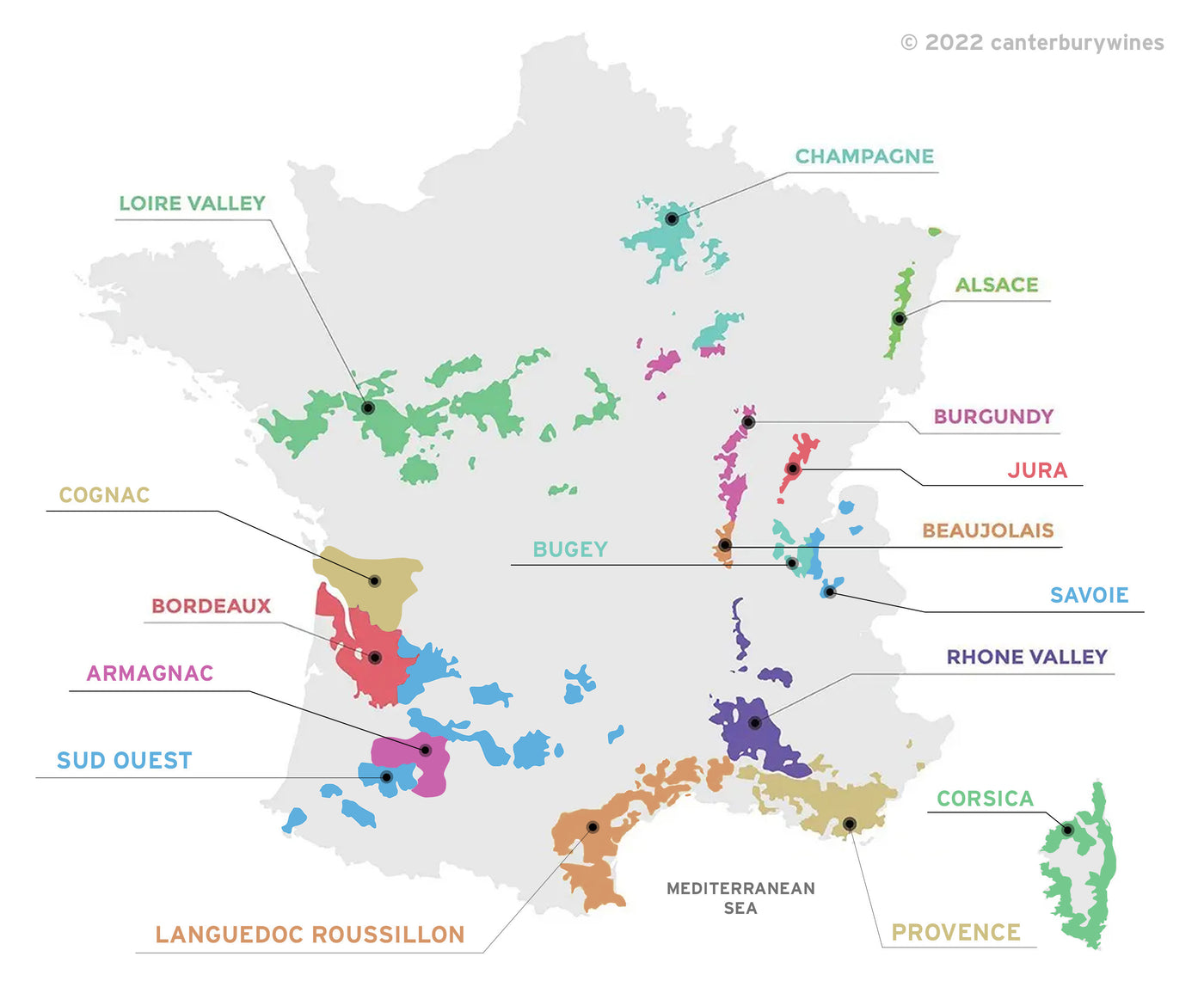
France
There are 16 major French wine regions, each known for their own unique grape varieties, terroir and wines. They are Alsace, Armagnac, Beaujolais, Bordeaux, Bugey, Burgundy, Champagne, Cognac, Corsica, Jura, Languedoc- Roussillon, Loire Valley, Provence, Savoie, South-West and the Rhône Valley.
The largest region is Languedoc- Roussillon, the oldest is Provence, the most influential and famous are Bordeaux, Burgundy, Champagne, Loire Valley and the Rhône Valley.
French wine is labelled by wine region or appellation rather than by grape variety (except in Alsace). In order to guarantee the quality and provenance of French wines, the French government established the Appellation d'origine contrôlée (AOC) system. Under this system the wine label indicates the geographical origin, quality and, generally, the style of a wine. Many regions are home to multiple appellations; for example, the prestigious Bordeaux region in the southwest of France has over 60 growing appellations.

